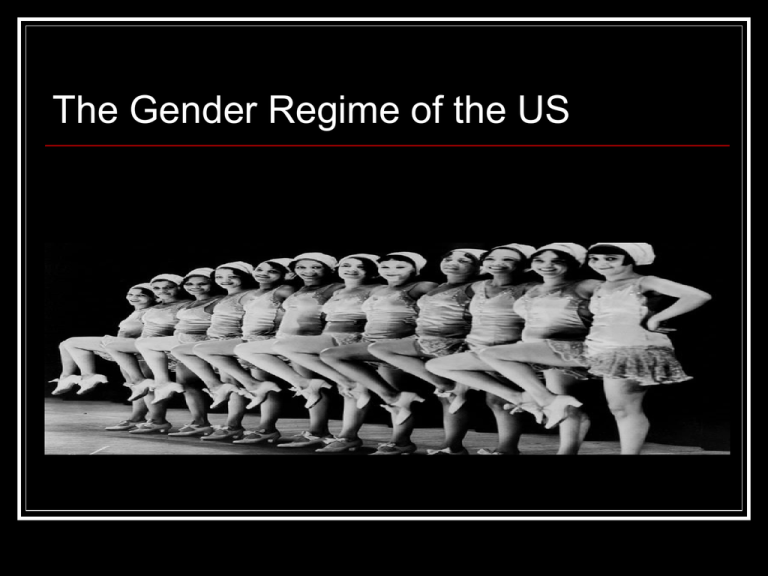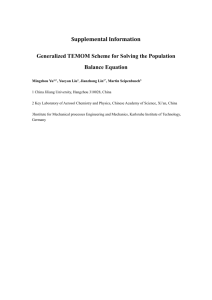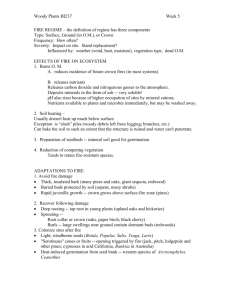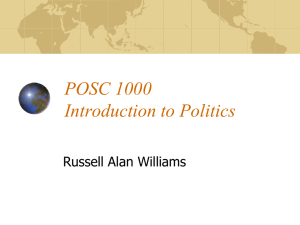PowerPoint Presentation - The Gender Regime of the US
advertisement

The Gender Regime of the US The Gender Regime of the US Definition of Gender Regime: the beliefs, customs, social structures, laws and institutions that structure women (and men’s) participation in civil society, the economy, and the state (Brunell, Lecture Notes, “Intro to Gender Regimes”). The Gender Regime of the US This presentation will discuss women’s status and roles in each of the three spheres comprising a Gender Regime: Civil Society the Economy the State (Politics) The Gender Regime of the US Civil Society Civil Society comprises the individual, family, groups (both formal and informal) Women play important and often under recognized roles in US Civil Society They are engines of social capital formation through their work in informal social networks They are social activists and political entrepreneurs And, they are central figures in American families; in fact, nearly one-fourth of American children grow up in mother-only households (http://www.childstats.gov/americaschildren/famsoc1.asp) The Gender Regime of the US Civil Society: Religion Religion in US 2001 American women’s roles in family and society have been significantly shaped by beliefs and values of America’s predominant religion: Christianity Refused 5% No Religion 14% Other 4% Christian 77% The Gender Regime of the US Religion: Christianity The first settlers of the US were Protestant Christians seeking freedom to practice their version of Christianity The Founders of the American Republic were Christians who espoused their belief in god and saw him as the source of “man’s inalienable rights” Thus, while American society has in some ways grown more secularized over time, the American Republic has been profoundly shaped by Christian beliefs and practices The Gender Regime of the US Religion: Christianity Christianity posits that the world was created by an omnipotent, omniscient god While most theologians describe the Christian god as being “genderless” or “beyond gender,” most Christians refer to god as “He” and “God, the Father” The Gender Regime of the US Religion: Christianity Most Christian denominations also deny women full participation in the church by refusing to ordain them or allow them to play pastoral or sacramental roles For these and many other theological reasons, many feminists refer to Christianity as a patriarchal religion The Gender Regime of the US Patriarchy Patriarchy is defined as: 1: social organization marked by the supremacy of the father in the clan or family, the legal dependence of wives and children, and the reckoning of descent and inheritance in the male line; broadly : control by men of a disproportionately large share of power (Merriam-Webster On-line, http://www.merriamwebster.com/dictionary/patriarchy). The US qualifies as a patriarchal society in that Property, inheritance and family name were exclusively male rights until the latter part of the 20th Century. Even today, the male-headed family is the cultural ideal and legal norm. Female-headed families are pathologized; in fact, socially, they do not exist except in the case where there is no male present in the home. The Gender Regime of the US Economy One reason female headed households are of concern is that they are disproportionately poor. This is partially explained by the fact that these households are surviving on one income. However, it also reflects the undervaluing of women’s labor, the concentration of women in the lowest paying jobs and professions, and the ways that women’s responsibility for child rearing disadvantage their work force participation. The Gender Regime of the US Motherhood Before going any further, we need to address an issue that has been raised by the presentation thus far. That is: the apparent conflation of women with motherhood. The Gender Regime of the US Motherhood I am not arguing that to be a mother is to be quintessentially female, or that all women become mothers. It is true, however, that at least 80% of all American women DO become mothers during their lifetimes (http://www.census.gov/population/www/socdemo/fertility.html). And that motherhood has a significant negative impact on their lifetime earnings (Crittenden, The Price of Motherhood, pp.88-93). It is also a fact that women are often viewed as “potential mothers” affecting the way they are perceived by employers (“We shouldn’t hire her; she’s just going to go off and get pregnant and leave us holding the bag.”) and many people in society (“Women shouldn’t be in combat because they are somebody’s mother.”) The Gender Regime of the US Economy In 2006, American women earned 81% of men’s wages. They worked an average of 36 hours/wk (compared to men’s 42). Among married heterosexual couples, women contributed only 35 percent of the family income in 2005. Yet, 25.5% of women in two earner heterosexual couples earned more than the men (2005). Source: Bureau of Labor Statistics. Women in the Labor Force: A Databook (2007 Edition). Available at: http://www.bls.gov/cps/wlfdatabook2007.htm The Gender Regime of the US Politics Women are under-represented in US politics The US ranks below the OECD average for the percentage of women in its national parliament Percentage of parliamentary seats held by women 2005 or latest year available Pourcentage de s i ges parlementaires d tenus par des femmes 50 45 40 35 30 25 20 15 10 5 0 TU R JP HUN N IT FR A GRA C IR KO L US R SVA CZK GBE POR CA L N PR L T OEUX C M D E AUX CH S DE E NZU L IS AUL BET L ES NL P DND K FI NON SWR E The Gender Regime of the US Politics Women comprise a higher percentage of state and local officials in the US. In 2008, women comprised 23.8% of all statewide elective executive offices across the country (still below the 30% goal set by the UN and found be “critical mass” for having an impact.) In State Legislature in 2008, women comprised 23.7% of state legislators in the United States. Since 1971, the number of women serving in state legislatures has more than quintupled. Source: Center for American Women and Politics, Eagleton Institute, Rutgers University. http://www.cawp.rutgers.edu/Facts.html#ele ctive The Gender Regime of the US Summary Regime Type Ideals Dominant Religion(s) Indivi dual Freedom (fro m gover nment) Christianity The Legal Protection of Private Property (the pursuit of happiness, the fruits of oneХs labors) Christian Indivi dualist Regime Strong separation between Public and Private Spheres Equal Opportunity Choice Belief in god Self-Reliance ТThe Lord helps those who help themselvesУ Protestants more numerous overall , but Catholics single larges t Christian denomination Ideal s for Women Women and girls are encourage d to develop stereotypically feminine traits and talents (e.g., passivity , being good listeners, working cooperativ ely, putting othersХinterest ahead of their own). Description of the Gender Regime Few formal/legal barriers to gender equal ity exist. Yet, Тthe glass ceilingУ is still in effect as womenХs dual roles as mothers and workers make s it less likely to have th e freed om to work long and irregular hours demanded in high status jobs. Women are significantly underrepres ented in the upper Women are excluded from Competitive, assertive an d echelons of corporate governanc e and in national politics and policy-making. Catholic and most Protestant successful women are church hierarch ies, but are often pathologized and Women are concentrated in fe w ordaine d in some faiths/sects criticized for not being occupations and these are the most (Presbyterian, Reform feminine enough. poorly paid. Judais m, e.g.) Women must always Market mechanisms are preferre d; maintain a youthful Many women are active in gender inequalities are seen as the other forms of spirituality, e.g. appearanc e. result of "priva te" or individual choices; New Age, pagani sm, Native American spiritual practices. Motherhoo d is seen as ТwomenХ s most important Reproductiv e labor not recognized as job.У contribution to society/economy merely a personal choice, lifestyle. The Gender Regime of the US Sources Bureau of Labor Statistics. 2007. Women in the Labor Force: A Databook (2007 Edition). Available at: http://www.bls.gov/cps/wlf-databook2007.htm Center for American Women and Politics. 2008. “Women in Elective Office 2008.” Center for American Women and Politics. Eagleton Institute. Rutgers University. Available at: http://www.cawp.rutgers.edu/Facts.html#elective Crittenden, Ann. 2001. The Price of Motherhood: Why the Most Important Job in the World Is Still the Least Valued. New York: Henry Holt & Co. The Gender Regime of the US Sources Dye Lawler, Jane. 2005. Fertility of American Women: June 2004. Current Population Reports. US Department of Commerce. Department of Labor. US Census Bureau. Washington, DC: US Government Printing Office. Available at: http://www.census.gov/population/www/socdemo/fertility.html Federal Interagency Forum on Child and Family Statistics. 2007. America's Children: Key National Indicators of Well-Being, 2007. Federal Interagency Forum on Child and Family Statistics. Washington, DC: U.S. Government Printing Office. Available at: http://www.childstats.gov/americaschildren/index.asp Merriam-Webster On-line. 2008. Entry for Patriarchy. Accessed June 10, 2008. Available at: http://www.merriam-webster.com/dictionary/patriarchy The Gender Regime of the US Sources U.S. Census Bureau. 2008. Statistical Abstract of the United States: 2008. Washington, DC: US Government Printing Office. Available at: http://www.census.gov/compendia/statab/2008edition.html





![Understanding barriers to transition in the MLP [PPT 1.19MB]](http://s2.studylib.net/store/data/005544558_1-6334f4f216c9ca191524b6f6ed43b6e2-300x300.png)
